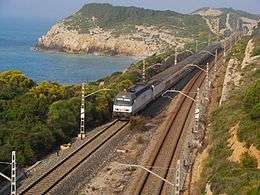Sleeping car
The sleeping car or sleeper (often wagon-lit) is a railway passenger car that can accommodate all passengers in beds of one kind or another, primarily for the purpose of making nighttime travel more comfortable. George Pullman was the American inventor of the sleeper car.
The first such cars saw sporadic use on American railroads in the 1830s; they could be configured for coach seating during the day. Some of the more luxurious types have private rooms (fully and solidly enclosed rooms that are not shared with strangers).
History
Possibly the earliest example of a sleeping car (or bed carriage, as it was then called) was on the London & Birmingham and Grand junction Railways between London and Lancashire, England. This was made available to first-class passengers in 1838.[1]
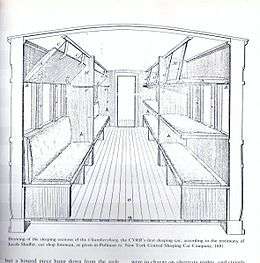
The Cumberland Valley Railroad pioneered sleeping car service in the spring of 1839, with a car named "Chambersburg", between Chambersburg and Harrisburg, Pennsylvania. A couple of years later a second car, the "Carlisle", was introduced into service.[2][3]
In 1857, the Wason Manufacturing Company of Springfield, Massachusetts – one of the United States ' first makers of railway passenger coach equipment – produced America's first specifically designed sleeping car.[4][5]
The man who ultimately made the sleeping car business profitable in the United States was George Pullman, who began by building a luxurious sleeping car (named Pioneer) in 1865. The Pullman Company, founded as the Pullman Palace Car Company in 1867, owned and operated most sleeping cars in the United States until the mid-20th century, attaching them to passenger trains run by the various railroads; there were also some sleeping cars that were operated by Pullman but owned by the railroad running a given train. During the peak years of American passenger railroading, several all-Pullman trains existed, including the 20th Century Limited on the New York Central Railroad, the Broadway Limited on the Pennsylvania Railroad, the Panama Limited on the Illinois Central Railroad, and the Super Chief on the Atchison, Topeka and Santa Fe Railway.
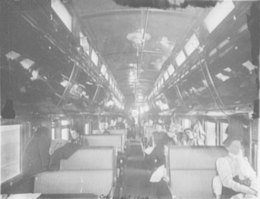
Pullman cars were normally a dark "Pullman green", although some were painted in the host railroad's colors. The cars carried individual names, but usually did not carry visible numbers. In the 1920s, the Pullman Company went through a series of restructuring steps, which in the end resulted in a parent company, Pullman Incorporated, controlling the Pullman Company (which owned and operated sleeping cars) and the Pullman-Standard Car Manufacturing Company. Due to an antitrust verdict in 1947, a consortium of railroads bought the Pullman Company from Pullman Incorporated, and subsequently railroads owned and operated Pullman-made sleeping cars themselves. Pullman-Standard continued manufacturing sleeping cars and other passenger and freight railroad cars until 1980.
For nearly a year at the end of World War II the United States government banned sleeping cars for runs of less than 450 miles.[6] The development of the Interstate Highway System in the 1950s and the expansion of jet airline travel in the same decade negatively impacted train travel.
Cultural impact of Pullman porters

One unanticipated consequence of the rise of Pullman cars in the US in the 19th and early 20th centuries was their effect on civil rights and African-American culture. Each Pullman car was staffed by a uniformed porter. The majority of Pullman Porters were African Americans. While still a menial job in many respects, Pullman offered better pay and security than most jobs open to African Americans at the time, in addition to a chance for travel, and it was a well regarded job in the African-American community of the time. The Pullman attendants, regardless of their true name, were traditionally referred to as "George" by the travelers, the name of the company's founder, George Pullman. The Pullman company was the largest employer of African Americans in the United States.[7] Subsequently, railway porters fought for political recognition and were eventually unionized. Their union, the Brotherhood of Sleeping Car Porters (established, 1925), became an important source of strength for the burgeoning Civil Rights Movement in the early 20th century, notably under the leadership of A. Philip Randolph. Because they moved about the country, Pullman porters also became an important means of communication for news and cultural information of all kinds. The African-American newspaper, the Chicago Defender, gained a national circulation in this way. Porters also used to re-sell phonograph records bought in the great metropolitan centres, greatly adding to the distribution of jazz and blues and the popularity of the artists.[8]
Open-section accommodation

From the 19th to the mid-20th century, the most common and more economical type of sleeping car accommodation on North American trains was the "open section". Open-section accommodations consist of pairs of seats, one seat facing forward and the other backward, situated on either side of a center aisle. The seat pairs can be converted into the combination of an upper and a lower "berth", each berth consisting of a bed screened from the aisle by a curtain. A famous example of open sections can be seen in the movie Some Like It Hot (1959).
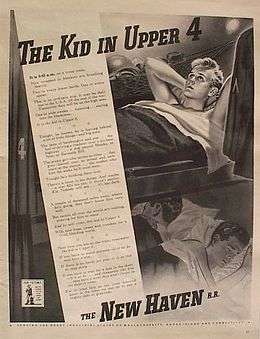
Private Accommodations
As the 20th century progressed, an increasing variety of private rooms was offered. Most of these rooms provided significantly more space than open-section accommodations could offer. Open-sections, in the 1950s were increasingly phased out, in favor of roomettes. Some of them, such as the rooms of the "Slumbercoach" cars manufactured by the Budd Company and first put into service in 1956, were triumphs of miniaturization. These allowed a single car to increase the number of sleepers over a conventional sleeping car of private rooms.[9]
Roomettes
A Roomette, in the historically correct sense of the word, is a private room for a single passenger, containing a single seat, a folding bed, a toilet (not in a private cubicle of its own), and a washbasin. When a traditional Roomette is in night mode, the bed blocks access to the toilet. Like open sections, Roomettes are placed on both sides of the car, with a corridor down the center. Duplex Roomettes, a Pullman-produced precursor to the Slumbercoach, are staggered vertically, with every second accommodation raised a few feet above the car's floor level, in order to make slightly more efficient use of the space. Single-passenger Slumbercoach accommodations are a particularly spartan form of roomette; Slumbercoaches also included a few two-passenger units.[9]
Compartments and Double Bedrooms
Compartments and Double Bedrooms are private rooms for two passengers, with upper and lower berths, washbasins, and private toilets, placed on one side of the car, with the corridor running down the other side (thus allowing the accommodation to be slightly over two thirds the width of the car). Frequently, these accommodations have movable partitions allowing adjacent accommodations to be combined into a suite.
Drawing Rooms and Larger Accommodations
A Drawing Room is a relatively rare accommodation for three people traveling together, again with a washbasin and private toilet, again on one side of the car. Even rarer are larger rooms accommodating four or more; generally the needs of large parties were better served with multiple rooms, with or without the ability to combine them into a suite.
Modern Amtrak Accommodations
Amtrak's Superliner Economy Bedrooms (now called Superliner Roomettes, although they are structurally closer to open sections) accommodate two passengers in facing seats that fold out into a lower berth, with an upper berth that folds down from above, a small closet, and no in-room washbasin or toilet, on both sides of both the upper and lower levels of the car. Effectively, they are open sections with walls, a door, and a built-in access ladder for the upper berth (which doubles as a nightstand for the lower berth passenger). Superliner Deluxe Bedrooms are essentially the same as historic Compartments and Double Bedrooms, with the toilet cubicle doubling as a private shower cubicle. In addition, each Superliner sleeping car has two special lower-level accommodations, each taking up the full width of the car: the Accessible Bedroom, at the restroom/shower end of the car (below the Deluxe Bedrooms), is a fully wheelchair-accessible accommodation for two, with a roll-in cubicle for the toilet and shower; the Family Bedroom, at the Economy Bedroom end of the car, accommodates two adults and up to three small children, without private toilet or shower facilities.
When the Viewliner sleeping cars were built, the accommodations were patterned after the Superliner accommodations, except that the Economy Bedrooms (or "Viewliner Roomettes") include Roomette-style washbasins and toilets, as well as windows for the upper berths.
Night trains today

Despite its recent overall decline in popularity, the overnight train still offers an enjoyable means of transportation for many. Many overnight trains are schduled to arrive at their destination cities in the morning. Although reduced in prevalence in recent decades in the Western world, sleeping cars retain a powerful ability to provide travel that is both reasonably comfortable and potentially time-saving, especially between points that are between 800 km (500 mi) and 1,600 km (1,000 mi) apart, distances one can travel overnight, perhaps with dinner at the beginning of the journey and breakfast at the end. This offers efficiency in passing the time and distance by allowing travelers to do things that might be done in a hotel room during the same hours. The obvious advantage over day trains (even high-speed ones) is that the ride takes up less daytime.
An interesting practice in sleeping car operation, one that is not currently employed in North America, is the use of "set-out" sleepers. Sleeping cars are picked up and/or dropped off at intermediate cities along a train's route so that what would otherwise be partial-night journeys can become (in effect) full-night journeys, with passengers allowed to occupy their sleeping accommodations from mid-evening to at least the early morning. Common practice on such occasions is to close the passages between sleeper cars for the night to prevent accidental wrong destinations.
Since 2009, China has been operating high speed sleeper trains.
Europe
In Europe, the Compagnie Internationale des Wagons-Lits (French for "International Sleeping Car Company") first focused on sleeping cars, but later operated whole trains, including the Simplon-Orient Express, Nord Express, Train Bleu, Golden Arrow, and the Transsiberien (on the Trans-Siberian railway). Today it once again specializes in sleeping cars, along with onboard railroad catering.
In modern Europe, a number of sleeping car services continue to operate, though they face strong competition from high-speed day trains and budget airlines, sometimes leading to the cancellation or consolidation of services. In some cases, trains are split and recombined in the dead of night, making it possible to offer several connections with a relatively small number of trains. Generally, the trains consist of sleeping cars with private compartments, couchette cars, and sometimes cars with normal seating.
An example of a more basic type of sleeping car is the European couchette car, which is divided into compartments for four or six people, with bench-configuration seating during the day and "privacyless" double- or triple-level bunk-beds at night.

Austria
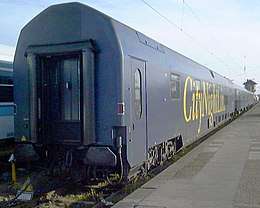
ÖBB's modern Nightjet services operate in Germany, Austria, Italy, Switzerland, and Belgium, and Nightjet's partners will also take passengers to Slovakia, Croatia, Slovenia, Poland, Hungary and the Czech Republic. The services usually leave at around 20:00 hours and arrive at around 09:00 hours at the destination.
.jpg)
Former Soviet Union Countries
In the former Soviet Union overnight train travel formed the main mode of long-distance travel. Distances between the capitals of Moscow and Kiev and many outlying cities being ideal for overnight trips that depart in late evening and arrive at their destinations in the morning. Sleeping cars with berths are the only reasonable solution for railway trips lasting several days (e.g., direct trains from Moscow to Siberian cities).
Night trains are to this day a prime method of travel in key Soviet Union successor states like Russia and Ukraine, where a shift towards faster daytime trains with seating rather than sleeping arrangements is hampered by insufficient investments in the railway infrastructure restricting the speed and by a lack of train sets. With its limited geography Belarus has managed to buck this post-Soviet trend and largely made the transition to daytime intercity trains, based on government-funded purchases of rolling stock supplied by Stadler, which operates a train factory in Minsk.[10]
The national rail services in Ukraine and Russia continue to operate a large number of sleeper trains, to a large extent based on vintage life-prolonged rolling stock assembled in East Germany back in the 1980s.
The use of the old cars help keeping ticket prices on a quite reasonable level by Western standards, starting at below 10 Euros for third-class tickets in Ukraine, with price levels higher in oil-rich Russia. Russia has renewed part of the fleet and introduced double-deck sleeper cars, but comfort levels suffer from a modest degree of innovation in the bogie suspension systems and the passenger compartment design. Around 2000 couchette and sleeper rail cars are in active service on the Ukrainian network, but only one is equipped with private first-class compartments with en-suite bathrooms, and new cars, purchased since 2015 in limited numbers, come without showers.
Croatia
Modern, air-conditioned sleeping cars and couchette cars are part of Croatian Railways rolling stock. Croatian sleeping coaches include single, double or 4-bed compartments with washbasin and many additional hygienic accessories. Passengers also have catering services at their disposal and are given complimentary breakfast, depending on the type of ticket bought. A night train with sleeping carriages included operates on the route between the two largest Croatian towns, Zagreb and Split, and Croatian sleeping coaches are included on the Zagreb-Munich-Zagreb and Zagreb-Zürich-Zagreb EuroNight lines.
France
Another of the more substantial examples of current European sleeping-car service is the Train Bleu, an all-sleeping-car train. It leaves Paris from the Gare d'Austerlitz in mid-evening and arrives in Nice at about 8 in the morning, providing both first-class rooms and couchette accommodation. The train's principal popularity is with older travelers; it has not won the same degree of popularity with younger travelers. Recently, the upper-class coaches (wagons lits) have been sold to foreign railroad companies, so that only couchette cars (1st and 2nd class) and seating coaches remain. The Train Bleu is part of the French night service network called Intercités de Nuit.
Italy
In Italy, Ferrovie dello Stato operates an extensive network of trains with sleeping cars, especially between the main cities in Northern Italy and the South, including Sicily using train ferry.
Poland
Sleeping trains in Poland are run by PKP Intercity.
Romania
Night train numbers have been reduced significantly, as the quality of the rail infrastructure is declining and repairs are insufficient, which leads to longer ride times between cities. A journey from the Bucharest main station to Arad (599 km) usually lasts 11 hours 20 minutes when there are no delays. Most night trains in Romania cross the country, covering distances of 400 to 750 km, usually to end at certain international destinations or in large cities at opposite ends of the country. The overwhelming majority of night trains with sleeping coaches are owned and operated by CFR Călători. Recently, private operators such as Astra Rail Carpatica, the newly-founded private operator of Astra Vagoane Arad, has started offering sleeping train services, using own-made sleeping cars and Servtrans locomotives.
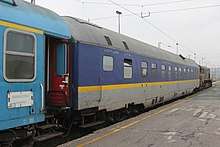
CFR today prefers operating more couchettes than sleeping cars in its trains, a practice used in Italy and Austria, adopted by the CFR in the early 2010s, thus enabling it to increase the capacity on sleeping trains. The sleeping cars of the CFR in the 1990s consisted of Bautzen and Görlitz-made sleeping cars, standard in the Eastern Bloc. They were replaced by Grivița-made WLABmee 71-70 and Hansa-made WLABmee 71–31, bought second-hand from Deutsche Bahn. The most recent sleeping-cars are the WLABmee 70-91 made by Astra Arad, which is the same type used by Astra Rail (although the liveries differ), starting from 2014, 2 of the WLABmee 71-70 cars were refurbished, but no other examples have received the same treatment. Other examples that have been withdrawn since were second-hand examples of the TEN MU and T2S types.
Spain and Portugal
In Spain, Trenhotel is a long-distance, high-quality overnight train service which uses Talgo tilting trains technology and sleeping cars developed by the Spanish rail network operator Renfe. It is operated by Renfe and CP where it operates International Sud-Express and Lusitanea between Spain and Portugal, and by its subsidiary Elipsos (a joint venture between Renfe and French SNCF with a 50% share each) when operating in France, Switzerland and Italy. The Estrella (Star) is a low-cost night train between Madrid and Barcelona served by berth carriages, with compartments for up to 6 people.
United Kingdom
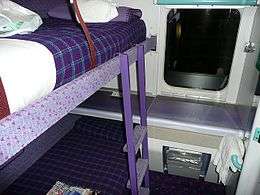
In the United Kingdom, a network of trains with sleeping cars operates daily between London and Scotland (Caledonian Sleeper), and between London and the West Country as far as Cornwall (Night Riviera). Using rolling stock designed and formerly operated by British Rail, these services offer a choice of single- or double-occupancy bedrooms. These services operate all week, except Saturdays and usually depart London (Euston and Paddington) in the evening, arriving at their destinations at approx 08:00. The West Country service uses British Rail Mk3 sleeper coaches, whereas Caledonian Sleeper replaced their Mk3 coaches with Mk 5 coaches.
Other countries in Europe with sleeping car services
North America
Canada
In Canada, all regularly scheduled sleeping car services are operated by Via Rail, using a mixture of relatively new cars and refurbished mid-century ones; the latter cars include both private rooms and "open section" accommodations.[11]
USA
In the United States, all regularly scheduled sleeping car services are operated by Amtrak. Amtrak offers sleeping cars on most of its overnight trains, using modern cars of the private-room type exclusively.
Today, Amtrak operates two main types of sleeping car: the bi-level Superliner sleeping cars, built from the late 1970s to the mid-1990s, and the single-level Viewliner sleeping cars, built in the mid-1990s. Superliners are used on most long-distance routes from Chicago westward, while Viewliners are used on most routes east of Chicago due to tunnel clearance issues in and around New York City and Baltimore.
In the most common Superliner sleeping car configuration, the upper level is divided into two halves, one half containing "Bedrooms" (formerly "Deluxe Bedrooms") for one, two, or three travelers, each Bedroom containing an enclosed toilet-and-shower facility; and the other half containing "Roomettes" (formerly "Economy Bedrooms" or "Standard Bedrooms") for one or two travelers; plus a beverage area and a toilet. The lower level contains more Roomettes; a Family Bedroom for as many as two adults and two children; and an "Accessible Bedroom" (formerly "Special Bedroom") for a wheelchair-using traveler and a companion; plus toilets and a shower.
The Viewliner cars contain an Accessible Bedroom (formerly "Special Bedroom") for a wheelchair-using traveler and a companion, with an enclosed toilet-and-shower facility; two Bedrooms (formerly "Deluxe Bedrooms") for one, two, or three travelers, each Bedroom containing an enclosed toilet-and-shower facility; "Roomettes" (formerly "Economy Bedrooms", "Standard Bedrooms", or "Compartments") for one or two travelers, each Roomette containing its own unenclosed toilet and washing facilities; and a shower room at the end of the car.
South America
Countries in South America having trains with sleeper cars
- Argentina
- Chile
Asia
China
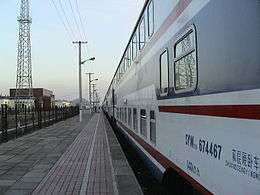
China Railway operates an extensive network of conventional sleeper trains throughout the country, covering all provincial capitals and many major cities. The Chinese "hard" sleeping car in use today is very basic, consisting of 6 fixed bunk beds per compartment, which can be converted into seats in peak season, especially during Chinese New Year. The middle level bunk bed will be folded and top level bunk bed will still be sold as sleeper, while the lower bed will be occupied by three passengers. Chinese trains also offer "soft" or deluxe sleeping cars with four or two beds per room.
China is the only country to operate high-speed sleeper trains. Sleeper services are operated using high-speed CRH1E, CRH2E and CRH5E trains outfitted with sleeping berths (couchette). Services run between Beijing - Shanghai and Beijing - Guangzhou at speeds of up to 250 km/h (160 mph), one of the fastest sleeper trains in the world.[12][13] A new variant of CRH2E consists of double deck capsules in lieu of sleeping berths. These trains have been dubbed "moving hotels".[14]
.jpg)
.jpg)
.jpg)
India
A major portion of passenger cars in India are sleeper/couchette cars. With railways as one of the primary mode of passenger transport, sleeper cars vary from economical to First Class AC (air conditioned). Most Indian trains come in combinations of first class A/C and non-A/C private sleeper cars with doors, and A/C and non-A/C 3-tier or 2-tier couchette arrangements.[15]
Japan
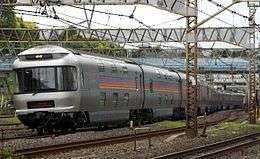
Japan once had many sleeping car trains, but most have been abolished because of the development of air travel, overnight bus services and high-speed rail. As of May 2016, sleeper car trains of regular service in Japan are as follows:
Malaysia
Keretapi Tanah Melayu, the Malaysian national railway company, offers sleeping car service on several of its long-distance trips. Sometimes the same trip can be made either during the day in a normal carriage or at night on a sleeper. The Kuala Lumpur to Hat Yai train has sleeping cars, since the journey takes 14 hours.
Indonesia
The Indonesian State Railways once had operated sleeper cars on the Bima between its launch in 1967 and 1995, when the last berth ("couchette") cars were decommissioned.
The successor to the Indonesian State Railways, PT Kereta Api Indonesia, operates some first-class train services that are officially called the Luxury class, but are misinterpreted as sleeper trains by mainstream media. There are two generations of Luxury class cars.[16][17]
Other countries in Asia
- Vietnam
- Turkey
- Iran
- India
- Pakistan
- Thailand
- Philippines: The Philippine National Railways operated a number of 7A-2000 and 14 class sleeper cars between 1999 and 2013. These units were first built for the Japanese National Railways in 1974 as 14 series passenger cars (ja), and were donated to the Philippines in 1999. They were meant to serve the Bicol Express in the South Main Line.[18] The 7A-2000 class were a group of 5 single-level cars that were decommissioned after being involved in the fatal 2004 Padre Burgos derailment.[19] On the other hand, the 14 class were a group of bilevel-style couchette cars. After all services to the Bicol Region were halted in 2013, the 14-class couchettes were stored in the Tutuban Yard in Manila.[18]
Africa
Countries in Africa having trains with sleeper cars
- Egypt
- Sudan
- Kenya
- Tanzania
- South Africa
- Namibia
- Botswana
- Democratic Republic of Congo
- Republic of the Congo
- Ivory Coast / Burkina Faso
- Mauritania
- Morocco
- Algeria
Oceania
Australia
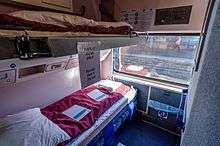
Sleeping cars are used on:
- Great Southern Rail's east–west transcontinental train the Indian Pacific between Sydney and Perth, and the north–south transcontinental train The Ghan between Adelaide and Darwin.
- NSW TrainLink's overnight XPT services from Sydney to Melbourne, Casino and Brisbane.
- Queensland Rail's long-distance trains the Spirit of Queensland and Spirit of the Outback.
See also
- Auto Train
- Jenny Lind private railroad car
- Jovita
- List of human habitation forms
- Lists of named passenger trains
- Pullman (car or coach)
- Troop sleeper
- Twinette
- Waltersburg
Notes
- Lambert, Anthony J. (1983), Travel in the Twenties and Thirties
- Philip Berlin Historical Marker – Behind the Marker Archived December 16, 2008, at the Wayback Machine
- "St. Paul 'Pullmans'". TIME Magazine. June 6, 1927. Retrieved 2008-05-28.
- "Firsts". Springfield 375. January 31, 2011. Archived from the original on March 14, 2012. Retrieved 2013-05-23.
- Bianculli, Anthony J. (2002). Trains and Technology: the American Railroad in the Nineteenth Century. Vol. 2, Cars. Newark, Del. [u.a.]: University of Delaware Press. p. 52. ISBN 0-87413-730-6.
- Editors of Publications International, 'How Stuff Works,' 'Railroads During World War II' https://history.howstuffworks.com/american-history/world-war-ii-railroads2.htm
- Grizzle, Stanley (1998). The Story of the Brotherhood of Sleeping Car Porters in Canada. Toronto: Umbrella Press. pp. 20–23, 39–42.
- Schoenberg, Loren. "Race Records". www.pbs.org. Public Broadcasting Service. Retrieved 5 December 2014.
- NRHS Bulletin, Summer 2006, Tom Smith, "The Budd Slumbercoach Brings Economy to Pullman Passengers" https://web.archive.org/web/20101128033028/http://srmduluth.org/Exhibits/SlumberCoaches.pdf
- "Locations - Stadler".
- "Train fleet - Rolling stock | VIA Rail".
- "Bombardier ZEFIRO Very High Speed Trains". Railway Technology. Retrieved 2020-06-07.
- "我国首列时速250公里纵向卧铺动车组下线-南方都市报·奥一网". epaper.oeeee.com. Retrieved 2020-06-07.
- "China's New High-Speed Sleeper Train is Literally a 'Moving Hotel'". nextshark. July 2017.
- "Essential Guide to Classes of Travel on Indian Railways Trains (with Photos)". TripSavvy. Retrieved 2017-09-07.
- "Mau naik kereta kelas sleeper - ini harga dan cara beli tiketnya". Kompas.com.
- "PT KAI Luncurkan Kereta Sleeper Luxury 2". Tribun News.
- Peadon, Brad (2020). "PNR Passenger Rolling Stock". Philippine National Railways Rolling Stock Update. 3.
- "10 dead in Philippines train derailment". NBC News, through the Associated Press. 2004-11-12. Retrieved 2020-03-28.
Sources
- White, John H. (1985) [1978]. The American Railroad Passenger Car. Baltimore, Maryland: Johns Hopkins University Press. ISBN 978-0-8018-2743-3.
- Martin, Andrew (2017). Night Trains: The Rise and Fall of the Sleeper. London: Profile Books. ISBN 9781781255605.
External links
![]()
![]()
- A. Philip Randolph / Sleeping Car Porters
- The Abraham Lincoln 1910 Heavyweight Pullman Business Car — photographs and short history.
- Canadian National Railways Sleeping Car No. 1683 St. Hyacinthe — photographs and short history of a Sleeping Car built in 1929.
- Sleeping in Comfort: Pullman Fundamentals
- Sleeping cars - photo gallery
- Sleeping cars from Argentina, USA, Scotland, Austria, Spain, Germany, Syria, Malaysia in interactive 360° Panoramas
- Pullman Sleeping Cars add Comfort to Overnight Travel, description, with illustrations, contrasting the roomettes, bedrooms, double bedrooms, drawing rooms and compartments
